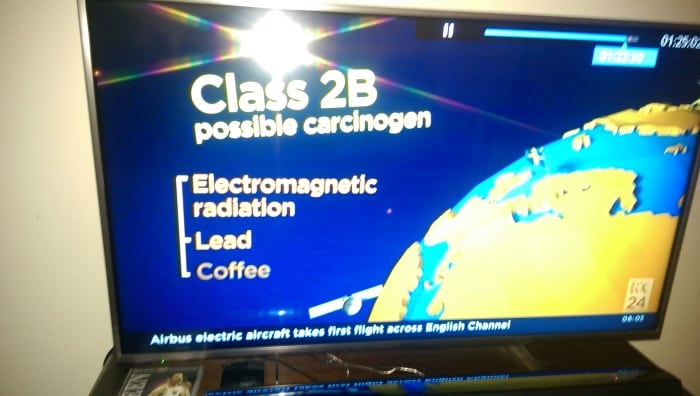I sat down to write a lovely piece about customer service, and the TV was on.
I looked up at a story that has been on rotation on the 24-hour news service, because I thought I heard them say something that sounded a bit silly.
It was a piece about electromagnetic radiation, and the people who claim they suffer from a sensitivity to it.
So, there’s not a lot of evidence that such a condition actually exists, and the main protagonist in the story, despite being a former university professor, is a member of the tinfoil hat brigade. Literally. He wears up to 10 metal-threaded skullcaps at one time. This makes him look like a Rabbi who’s swimming at the Masters Games.
As part of the article, they mentioned that EM sensitivity is recognised as a disability in Sweden – albeit only by self-diagnosis as doctors won’t diagnose it – and that it’s on the World Health Organisation’s Carcinogen List, in the same category as Lead and Coffee.
WOAH! Back up a minute! LEAD and COFFEE? did I mishear?
A quick rewind and a screen shot from the TV:
Yes, that is indeed what they said.So all thoughts of lovely customer service post on hold, time for some research.Turns out the IARC is the arm of the WHO which deals with cancer, and they had a look at 900 possible carcinogens and categorised them according to this scheme:
Group 1: Carcinogenic to humans
Group 2A: Probably carcinogenic to humans
Group 2B: Possibly carcinogenic to humans
Group 3: Unclassifiable as to carcinogenicity in humans
Group 4: Probably not carcinogenic to humans
The list itself is a study in being non-committal. You’ll notice there is no category which rules anything out to any greater degree than ‘probably’.
There are 117 agents in category 1, and 74 in Category 2A. That’s the stuff you want to avoid, like “Non-arsenical insecticides (occupational exposures in spraying and application of)” and plutonium.
But 2B? How do lead, coffee and electromagnetic radiation all get lumped together in that category? What what else is in there?
I mean, lead is bad for you, we all know that. Coffee is generally considered to be not bad for you, and EM radiation is at best a bedfellow to wind turbine syndrome and death by overexposure to Kanye West: we all admit it’s possible, but it seems a little unlikely.
Others in the category seem a little diverse and bordering on taking a broad brush approach: Progestogen-only contraceptives, working in the printing industry, talcum powder and surgical implants all turn up.
To add more context, as I type, the TV is now saying if you sleep less than 6 hours sleep per night, you’ll die early, so I’ll type fast.
Speaking of sleep, I noticed that shift work which disrupts your circadian rhythms is actually on the list in category 2A, so if you are drinking coffee to stay awake for your night shift at a printing press, you need to get your affairs in order right now. Particularly if you are taking contraceptives and don’t mind a bit of post-shower talcum.
The question that is, of course, burning at the edge of this is: What about tea?
Is it perhaps the one – yes one – category 4 substance? No, that honour belongs to Caprolactam , which is a somewhat toxic (but probably not carcinogenic) precursor to Nylon manufacture.
I won’t keep you in suspense any longer: it’s category 3. Along with things like Paracetamol, mustard and PVC.
So, that all sounds slightly comforting. It’s tempting to add “Drink more tea, it’s rated by the WHO IARC as Unclassifiable as to carcinogenicity in humans” to our packaging, but for now, we might give it a miss.
Or at least, we’ll sleep on it.

Comments
2 responses to “2B and not 2B”
And next time, you will find a study saying that tea is bad for health (and no one will believe it) 😉
One time, while extolling the virtues of Lapsang Souchong, someone (I forget who) told me that – due to the smoking process – it was more carcinogenic than before.
For some reason, that just made me want to drink MORE of the stuff.